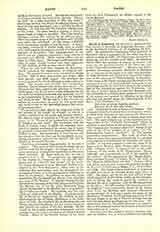

David of Augsburg (DE AUGUSTA), medieval German mystic, b. probably at Augsburg, Bavaria, early in the thirteenth century; d. at Augsburg, November 19, 1272. He entered the Franciscan Order probably at Ratisbon, where a monastery of this order was in existence as early as 1226; the Franciscan monastery at Augsburg was not erected until 1243. At Ratisbon David filled the position of master of novices and wrote for the spiritual benefit of the latter his celebrated “Formula Novitiorum”. Whether the distinguished Franciscan preacher Berthold of Ratisbon (q.v.) was one of his pupils is at least very doubtful. In 1246 Berthold and David were appointed inspectors of the convent of Niedermunster at Ratisbon. From about 1250 David accompanied Berthold on his missionary tours and most probably took part in the preaching himself; he also had a share in the proceedings of the Inquisition against the Waldenses. On the day of David’s death it is said that Berthold, who was preaching in a distant place, stopped in the midst of his sermon and quoted, in reference to his friend who had just passed away, the following lines of the hymn, “Iste Confessor“:
Qui pius, prudens, humilis, pudicus,
Sobriam duxit sine labe vitam
—etc. David wrote both in Latin and German. For a long period his Latin works were attributed to others, at times to St. Bernard of Clairvaux and St. Bonaventure, a proof of the high esteem in which they were held. The most striking case of this mistaken ascription is that of the “Formula Novitiorum” which in addition to two letters of David form three books: (I) “De Compositione hominis exterioris” (treats of the external life of the member of an order); (2) “De Reformatione hominis interioris”; (3) “De septem processibus religiosorum”. This work, of which the different parts often appeared separately, is a rational and progressive introduction to monastic and mystical life. It was first published under the name of St. Bonaventure (Brescia, 1485; Venice, 1487; Antwerp, 1591; Cologne, 1618); it appeared also in the editio Vaticana of the works of St. Bonaventure (Rome, 1588-96), and consequently in all of the reprints of this edition. It also appeared in the “Magna Bibliotheca veterum Patrum” (Cologne, 1618), vol. XIII, in the “Maxima Bibliotheca vet. Patr.” (Lyons, 1675), vol. XXV, and, in part, among the doubtful works of St. Bernard of Clairvaux in Migne, P.L., CLXXXIII, col. 1189. The Latin edition published at Augsburg in 1596 was issued in German at the same place in 1597. The latest and by far the best edition is that which appeared at Quaracchi (1889), in the introduction to which the work is positively ascribed to Brother David of Augsburg; a list of 370 manuscripts is also given. David’s treatise “De hresi pauperum de Lugduno” was erroneously issued, in an incomplete form, by Martene and Durand (Thesaurus novus anecdot., V, 1777 sqq.) under the name of the Dominican Yvonnet; but it has been proved by Pfeiffer and Preger to be one of David’s writings and the full text was edited by Preger for the first time. Extracts from David’s “Expositio Regulae”, an explanation of the monastic rules of St. Francis of Assisi, have been edited by E. Lempp.
Attention was first called to David’s German writings by Pfeiffer, who in 1845 published the following eight treatises and ascribed them to David: (I) “Die sieben Vorregeln der Tugend”; (2) “Der Spiegel der Tugend”; (3) “Christi Leben unser Vorbild” (to this treatise Pfeiffer found later a continuation five times larger than the part published); (4) “Die vier Fittiche geistlicher Betrachtung”; (5) “Von der Anschauung Gottes”; (6) “Von der Erkenntnis der Wahrheit; (7) “Von der unergriindlichen Fiille Gottes; (8) “Betrachtungen and Gebete”. Preger raised doubts as to the correctness of ascribing these tractates, with exception of the first three, to David, but his attack proved a failure and Pfeiffer’s views have been successfully defended by Hecker and Tellinegg. It must, however, be acknowledged that the eighth contains much that was common property in the Middle Ages. David’s German treatises are fine examples of German prose and assure him a permanent place in the history of German literature. Like the radiance of a gently burning flame they attract the heart and spirit of the reader to the beautiful and the Divine. They turn the mind from vice and error with most convincing eloquence and kindle in it the love of God. In these writings, as in the treatises for novices, David is at all times the circumspect mystic, averse to fantastic ecstasy and exaggeration. A sober good sense pervades his profound yet animated expositions, which have nothing in common with the vagaries of the German mystics of the fourteenth century, although David’s influence on the latter is not to be denied. His writings exerted some influence also on the “Schwabenspiegel” (Swabian Mirror), the well-known compilation of civil law used in Southern Germany, which appeared about 1268. Personally David belonged to the earlier school of mystics.
MICHAEL BIHL

